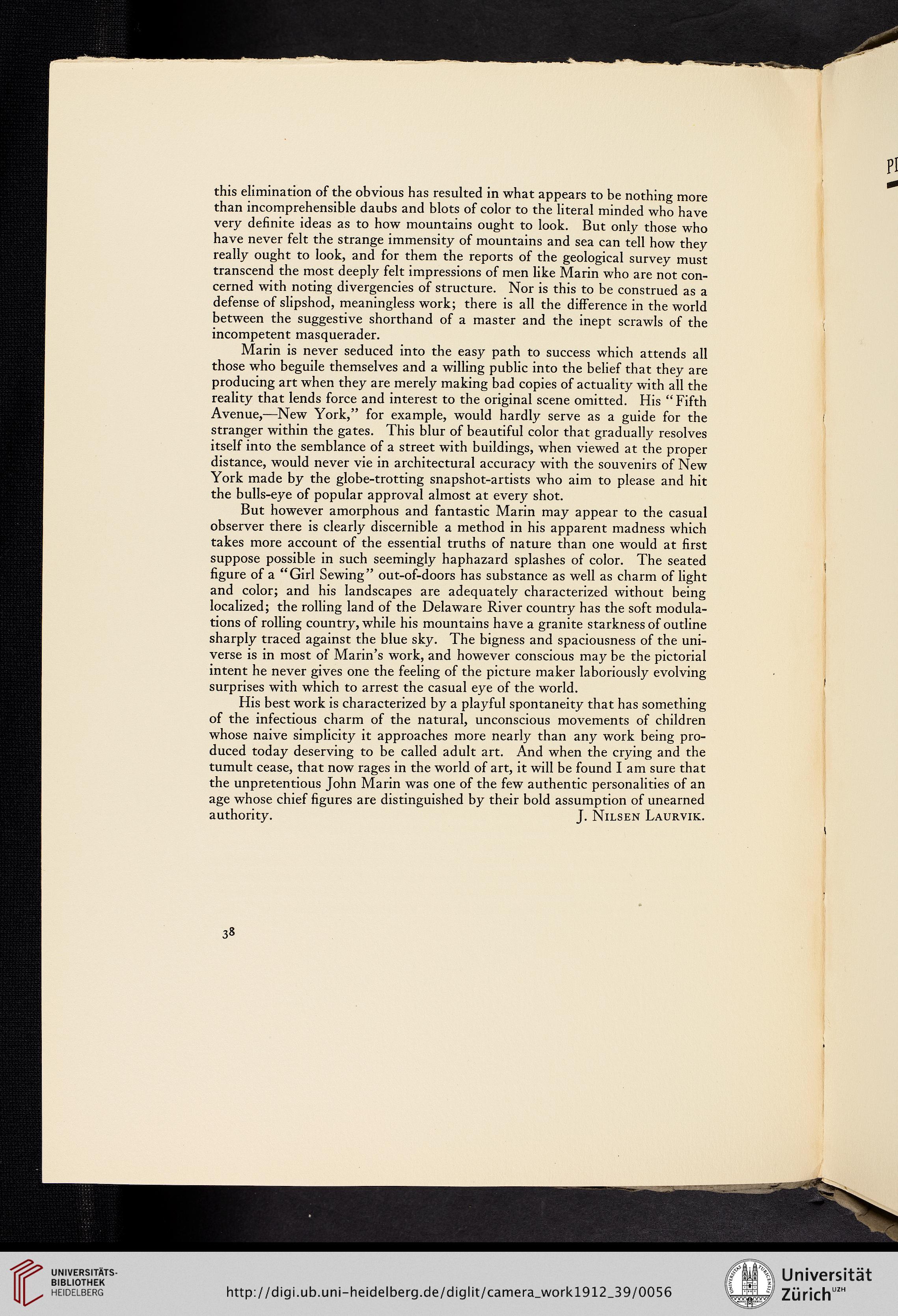Für diese Seite ist auch eine manuell angefertigte Transkription bzw. Edition verfügbar. Bitte wechseln Sie dafür zum Reiter "Transkription" oder "Edition".
this elimination of the obvious has resulted in what appears to be nothing more
than incomprehensible daubs and blots of color to the literal minded who have
very definite ideas as to how mountains ought to look. But only those who
have never felt the strange immensity of mountains and sea can tell how they
really ought to look, and for them the reports of the geological survey must
transcend the most deeply felt impressions of men like Marin who are not con-
cerned with noting divergencies of structure. Nor is this to be construed as a
defense of slipshod, meaningless work; there is all the difference in the world
between the suggestive shorthand of a master and the inept scrawls of the
incompetent masquerader.
Marin is never seduced into the easy path to success which attends all
those who beguile themselves and a willing public into the belief that they are
producing art when they are merely making bad copies of actuality with all the
reality that lends force and interest to the original scene omitted. His “Fifth
Avenue,—New York,” for example, would hardly serve as a guide for the
stranger within the gates. This blur of beautiful color that gradually resolves
itself into the semblance of a street with buildings, when viewed at the proper
distance, would never vie in architectural accuracy with the souvenirs of New
York made by the globe-trotting snapshot-artists who aim to please and hit
the bulls-eye of popular approval almost at every shot.
But however amorphous and fantastic Marin may appear to the casual
observer there is clearly discernible a method in his apparent madness which
takes more account of the essential truths of nature than one would at first
suppose possible in such seemingly haphazard splashes of color. The seated
figure of a “Girl Sewing” out-of-doors has substance as well as charm of light
and color; and his landscapes are adequately characterized without being
localized; the rolling land of the Delaware River country has the soft modula-
tions of rolling country, while his mountains have a granite starkness of outline
sharply traced against the blue sky. The bigness and spaciousness of the uni-
verse is in most of Marin’s work, and however conscious may be the pictorial
intent he never gives one the feeling of the picture maker laboriously evolving
surprises with which to arrest the casual eye of the world.
His best work is characterized by a playful spontaneity that has something
of the infectious charm of the natural, unconscious movements of children
whose naive simplicity it approaches more nearly than any work being pro-
duced today deserving to be called adult art. And when the crying and the
tumult cease, that now rages in the world of art, it will be found I am sure that
the unpretentious John Marin was one of the few authentic personalities of an
age whose chief figures are distinguished by their bold assumption of unearned
authority. J. Nilsen Laurvik.
38
than incomprehensible daubs and blots of color to the literal minded who have
very definite ideas as to how mountains ought to look. But only those who
have never felt the strange immensity of mountains and sea can tell how they
really ought to look, and for them the reports of the geological survey must
transcend the most deeply felt impressions of men like Marin who are not con-
cerned with noting divergencies of structure. Nor is this to be construed as a
defense of slipshod, meaningless work; there is all the difference in the world
between the suggestive shorthand of a master and the inept scrawls of the
incompetent masquerader.
Marin is never seduced into the easy path to success which attends all
those who beguile themselves and a willing public into the belief that they are
producing art when they are merely making bad copies of actuality with all the
reality that lends force and interest to the original scene omitted. His “Fifth
Avenue,—New York,” for example, would hardly serve as a guide for the
stranger within the gates. This blur of beautiful color that gradually resolves
itself into the semblance of a street with buildings, when viewed at the proper
distance, would never vie in architectural accuracy with the souvenirs of New
York made by the globe-trotting snapshot-artists who aim to please and hit
the bulls-eye of popular approval almost at every shot.
But however amorphous and fantastic Marin may appear to the casual
observer there is clearly discernible a method in his apparent madness which
takes more account of the essential truths of nature than one would at first
suppose possible in such seemingly haphazard splashes of color. The seated
figure of a “Girl Sewing” out-of-doors has substance as well as charm of light
and color; and his landscapes are adequately characterized without being
localized; the rolling land of the Delaware River country has the soft modula-
tions of rolling country, while his mountains have a granite starkness of outline
sharply traced against the blue sky. The bigness and spaciousness of the uni-
verse is in most of Marin’s work, and however conscious may be the pictorial
intent he never gives one the feeling of the picture maker laboriously evolving
surprises with which to arrest the casual eye of the world.
His best work is characterized by a playful spontaneity that has something
of the infectious charm of the natural, unconscious movements of children
whose naive simplicity it approaches more nearly than any work being pro-
duced today deserving to be called adult art. And when the crying and the
tumult cease, that now rages in the world of art, it will be found I am sure that
the unpretentious John Marin was one of the few authentic personalities of an
age whose chief figures are distinguished by their bold assumption of unearned
authority. J. Nilsen Laurvik.
38


